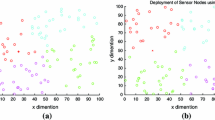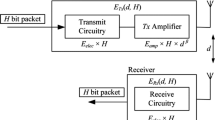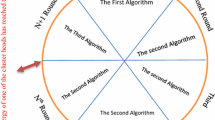Abstract
Wireless sensor network consists of a number of power constrained sensor nodes that sense data from the environment. The collected data is directed to the base station in a harmonized way. Under such circumstances, the foremost challenges of sensor networks are limited energy, system lifetime, latency, quality of information, and limited communication bandwidth. Clustering methods enable to reuse the bandwidth and better resource allocation in order to maintain stable power control. In this paper the election of cluster head among the region cluster members is carried out through Adaptive Buffering with Fuzzy based Multilevel clustering (ABFMC). The proposed algorithm facilitates all nodes to communicate with the base station through a unique number of buffer nodes. Here, the decision based on distance factor is made by the selection of transmission through cluster head. Simulation results show that the proposed ABFMC algorithm provides better network lifetime and efficient energy distribution among the nodes.















Similar content being viewed by others
References
Akyildiz, F., & Kasimoglu, I. H. (2004). Wireless sensor and actor networks: Research challenges. Ad Hoc Networks,2(4), 351–367.
Poonguzhali, P. K., Ananthamoorthy, N. P., & Jabakani, S. J. (2015). Design challenges and comprehensive study on cluster based routing protocol in wireless sensor network. Int. Journal of Advanced Research in Computer and Communication Engineering, 4(1), 5–11.
Kumar, P., & Chand, N. (2013). Clustering in wireless multimedia sensor networks. Journal of Sensor Technology,3, 126–132. (Published Online December 2013).
Liu, X. (2012). A survey on clustering routing algorithms in wireless sensor networks. Guangzhou: School of Electronic and Information Engineering, South China University of Technology.
Heinzelman, W. R., Chandrakasan, A., & Balakrishan, H. (2002). Energy efficient communication algorithm for wireless micro sensor networks. Communications Review,6, 28–36. (Proceedings of IEEE HICSS (January 2000)).
SEP: A Stable Election Algorithm for clustered heterogeneous wireless sensor networks GEORGIOS SMARAGDAKIS IBRAHIM MATTA AZER BESTAVROS Computer Science Department Boston University (2004).
Qin, M., & Zimmermann, R. (2007). VCA: An energy efficient voting based clustering algorithm for sensor networks. Journal of Universal Computer Science,13(1), 87–109.
Chatterjee, M., Das, S. K., & Turgut, D. (2002). WCA: A weighted clustering algorithm for mobile ad hoc networks. Journal of Cluster Computing (Special Issue on Mobile Ad hoc Networks),5(2), 193–204.
Banerjee, S., & Khuller, S. (2001). A clustering scheme for hierarchical control in multi-hop wireless networks. IEEE INFOCOM, pp. 1028–1037.
Ding, P., Holliday, J., & Celik, A. (2005). Distributed energy-efficient hierarchical clustering for wireless sensor networks. In International conference on distributed computing in sensor systems (pp. 322–339).
Ye, M., Li, C., Chen, G., & Wu, J. (2005). EECS: An energy efficient clustering scheme in wireless sensor networks. In Proceedings of the 24th IEEE international performance, computing, and communications conference (IPCCC), Phoenix, AZ, USA, 7–9 April 2005, pp. 535–540.
Soro, S., & Heinzelman, W. (2005). Prolonging the lifetime of wireless sensor networks via unequal clustering. In Proceedings of the 5th IEEE international workshop on algorithms for wireless, mobile, ad hoc and sensor networks (WMAN), Denver, CO, USA, 4–8 April 2005, pp. 236–243.
Li, C. F., Ye, M., Chen, G. H., & Wu, J. (2005). An energy-efficient unequal clustering mechanism for wireless sensor networks. In Proceedings of the 2nd IEEE international conference on mobile ad hoc and sensor systems conference (MASS), Washington, DC, 7–10 November 2005, pp. 596–604.
Kim, J. M., Park, S. H., Han, Y. J., & Chung, T. M. (2008). CHEF, cluster head election mechanism using fuzzy logic in wireless sensor networks. In Proceedings of the ICACT, pp. 654–659.
Gupta, I., Riordan, D., & Sampalli, S. (2005). Cluster-head election using fuzzy logic for wireless sensor networks. In Proceedings of the 3rd annual communication networks and services research conference, 2005, pp. 255–260.
Buttyan, L., & Schaffer, P. (2010). PANEL: Position-based aggregator node election in wireless sensor networks. International Journal of Distributed Sensor Networks,2010, 1–16.
Chan, H., & Perrig, A. (2004). ACE: An emergent algorithm for highly uniform cluster formation. In Proceedings of the 1st European workshop on sensor networks (EWSN), Berlin, Germany, 19–21 January 2004, pp. 154–171.
Murugunathan, S. D., Ma, D. C. F., Bhasin, R. I., & Fapajuwo, A. O. (2005). A centralized energy-efficient routing algorithm for wireless sensor networks. IEEE Radio Communications,43, S8–S13.
Manjeshwar, E., & Agrawal, D. P. (2001). TEEN: A routing algorithm for enhanced efficiency in wireless sensor networks. In Proceedings of the 15th international parallel and distributed processing symposium (IPDPS), San Francisco, CA, USA, 23–27 April 2001, pp. 2009–2015.
Jung, S., Han, Y., & Chung, T. (2007). The concentric clustering scheme for efficient energy consumption in the PEGASIS. In Proceedings of the 9th international conference on advanced communication technology, Gangwon-Do, Korea, 12–14 February 2007, pp. 260–265.
Shankar, T., Karthikeyan, A., Sivasankar, P., & Rajeev, R. N. (2015). Implementation of smart sleep mechanism and hybrid data collection technique for maximizing network lifetime in WSN’s. Indian Journal of Science and Technology, 8(S9), 1–8.
Shankar, T., Karthikeyan, A., Sivasankar, P., & Rajesh, A. (2017). Hybrid approach for optimal cluster head selection in wsn using leach and monkey search algorithms. Journal of Engineering Science and Technology,12(2), 506–517.
Shankar, T., & Shanmugavel, S. (2013). Hybrid approach for energy optimization in wireless sensor network using ABC and firefly. International Review on Computers and Software,8(10), 2335–2341.
Shankar, T., & Shanmugavel, S. (2014). Energy optimization in cluster based wireless sensor networks. Journal of Engineering Science and Technology, School of Engineering, Taylor’s University,9(2), 246–260.
Author information
Authors and Affiliations
Corresponding author
Additional information
Publisher's Note
Springer Nature remains neutral with regard to jurisdictional claims in published maps and institutional affiliations.
Rights and permissions
About this article
Cite this article
Shankar, T., Rajesh, A. & Mageshvaran, R. Adaptive Buffering and Fuzzy Based Multilevel Clustering for Energy Efficient Wireless Sensor Network. Wireless Pers Commun 112, 353–370 (2020). https://doi.org/10.1007/s11277-020-07029-3
Published:
Issue Date:
DOI: https://doi.org/10.1007/s11277-020-07029-3




